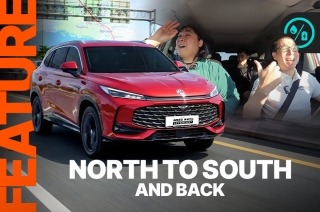SUVs vs Crossovers: What's the difference? – Behind a Desk
We go over the differences between SUVs and crossovers. Caco explains the pros and cons of both in this episode of Behind a Desk. Know if a crossover is right for you or if an SUV is better. Does the refinement and comfort of a unibody make you swoon, or does the rugged strength of the ladder frame attract you more?
It starts with multiple pieces of metal. Then all of those pieces join together to form the bones of what will become the bones of what we know as a Sport-Utility Vehicle, or SUV for short. These vehicles are built in the same way pickup trucks are, tough and burly, ready to carry heavy loads and trample all forms of terrain, or it can be used to haul groceries, pick up the kids because it also built with utility in mind. SUVs, however, have a rather unrelated cousin, or doppelganger if you will, and that is the crossover. Still made up of multiple pieces of metal, instead of a ladder frame, this kind of car uses a unibody, which is more car-like.
SUVs
When it comes to rugged rigs, an SUV is one of the default choices for people that want a long-lasting, hard-wearing, and strong vehicle that should stand the test of time. With many models spanning many eras, SUVs used to be the only choice for consumers looking for a car that features high ground clearance.
An SUV would normally be based on a pickup truck, which is already built for strength. Manufacturers will often swap out the rear leaf-springs for coil springs, while others like Nissan in their Terra and Navarra, both outfit their cars with multi-link coil spring suspension. More often than not, SUVs also employ a longitudinal engine layout, which means that the crankshaft is positioned perpendicular to the axles. That's why most SUVs without a 4x4 system are rear-wheel drive. Also, another difference between SUVs and crossovers is that they use a four-wheel-drive system, while a crossover will use an all-wheel-drive system.
Examples of SUVs in the Philippines include the Toyota Fortuner, the Ford Expedition, and even the Suzuki Jimny.
Crossovers
Often referred to as a compact SUV or CUV in some circles, a crossover is essentially raised hatchback. The layout of a crossover is very similar to that of your average sedan. With a transverse engine placement, which means that the crankshaft is parallel to the front axles, a crossover without its all-wheel-drive system, will only drive the front wheels. This is more in line with a modern passenger car than an SUV. Since the front wheels are being driven, crossovers typically feature a more compact build as compared to an SUV of the same segment.
Another key difference that a crossover has is its unibody construction. While an SUV uses a ladder-frame, a crossover will use a unibody chassis that helps reduce weight and allows engineers to design in more rigidity without gaining more mass. This allows crossovers to feature engines that are not as big and even better ride comfort. Because of the lower weight, you can expect these types of vehicles to have better fuel economy. Instead of four-wheel-drive, which needs to be turned on and off, a crossovers all-wheel-drive system is able to drive all four wheels on demand, no need to toggle a switch to get power to all four. Handling is also improved thanks to a lower center of mass and lighter weight. Crossovers handle more similarly to cars and don't roll through corners as much as an SUV.
Examples of these crossovers include the Honda CR-V, the Geely Coolray, the Ford Explorer and the Mazda CX-9











